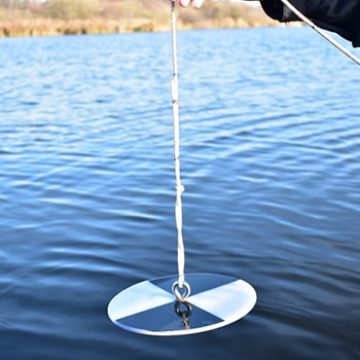Water Quality Monitoring
Frequent water sampling allows changes in water quality to be surveyed over time.

Water Quality Monitoring
Water sampling to help understand the improvements over time to the broad.

Water Quality Monitoring: Science Officer Overview
Read our science officer overview on water quality monitoring.

Measuring water quality is a vital part of the project’s monitoring. It helps us understand the current poor water quality within Hoveton Great Broad. It will also allow us to measure the improvements in water quality delivered through the restoration.
We undertake water quality monitoring monthly, gathering field data (measurements we can take on site) and water samples which get sent off for analysis. During the sampling we gather data to tell us about:
Water clarity – Measuring how clear the water is, tells us how much light is reaching the lakebed. It is important that light can reach the lakebed to allow water plants to grow. Water plants are the foundation of a healthy wildlife rich lake. The water within Hoveton Great Broad is currently murky, preventing water plants from growing, but through restoration we hope to restore clear water.
Nutrients in the water – All plants need nutrients to grow, but when you get too many nutrients in lakes it is algae that take advantage, turning the water murky and blocking light to the water plants. We measure nutrients in the water to see if nutrient levels are low enough to prevent the broad returning to being murky and algal dominated following restoration.
Algae and water fleas – the ratio between algae (phytoplankton) and water fleas (zooplankton) will be a key indicator of successful restoration. Our water quality monitoring shows phytoplankton numbers are currently high, causing murky water conditions. Following biomanipulation, we expect zooplankton to increase as we reduce predation pressure from fish. The zooplankton, which eat phytoplankton, will increase and phytoplankton numbers to decrease creating clear water.
We also gather other water quality measures such as pH, dissolved oxygen, and conductivity. These can all indicate any changes in water quality such as pollution or increased salt in the water from a tidal surge.

The data we have gathered prior to biomanipulation of Hoveton Great Broad and Hudson’s Bay show high levels of turbidity (the murkiness of water) and high numbers of algae. Secchi Disk – a Secchi disk is used to measure water clarity. You the disk into the water until you can no longer see the black and white pattern. The depth the disk is no longer visible (measured off the attached string) is your Secchi disk measurement.
